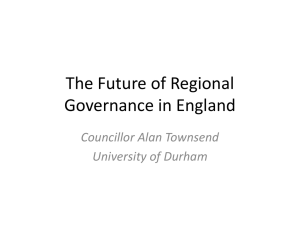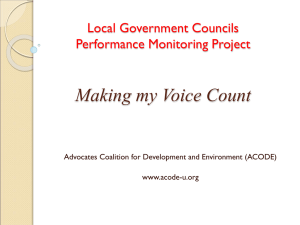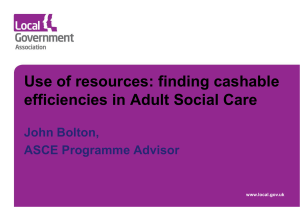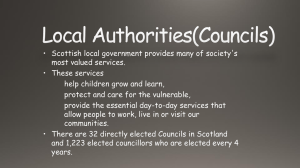Removing Barriers to Water Infrastructure Development in the Local
advertisement
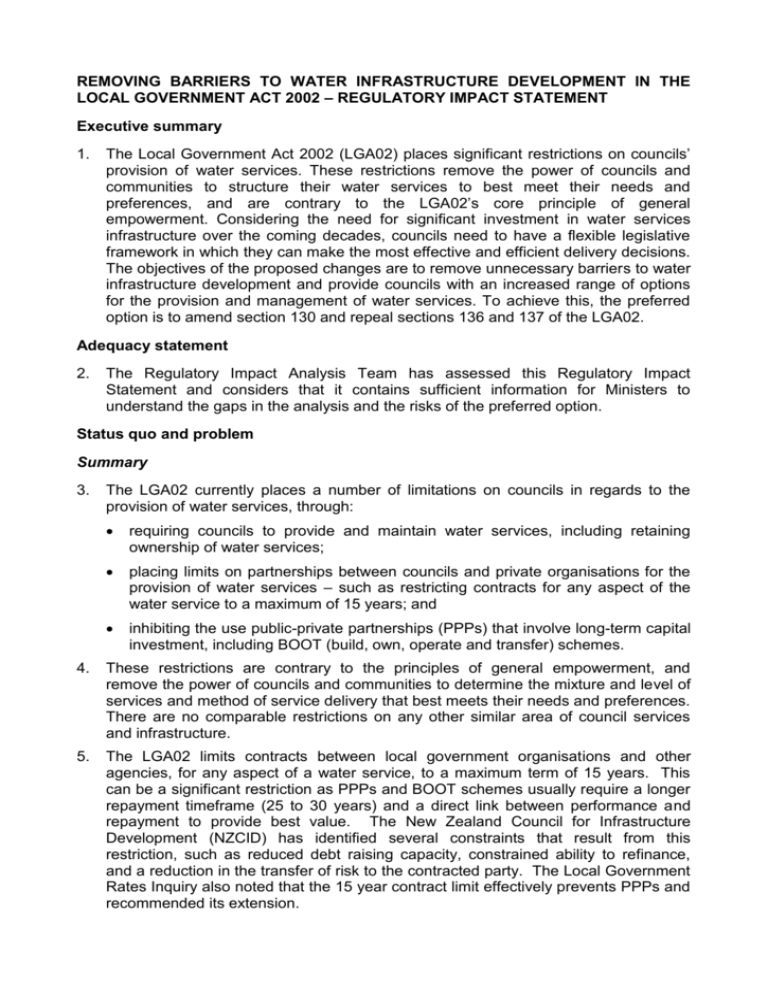
REMOVING BARRIERS TO WATER INFRASTRUCTURE DEVELOPMENT IN THE LOCAL GOVERNMENT ACT 2002 – REGULATORY IMPACT STATEMENT Executive summary 1. The Local Government Act 2002 (LGA02) places significant restrictions on councils’ provision of water services. These restrictions remove the power of councils and communities to structure their water services to best meet their needs and preferences, and are contrary to the LGA02’s core principle of general empowerment. Considering the need for significant investment in water services infrastructure over the coming decades, councils need to have a flexible legislative framework in which they can make the most effective and efficient delivery decisions. The objectives of the proposed changes are to remove unnecessary barriers to water infrastructure development and provide councils with an increased range of options for the provision and management of water services. To achieve this, the preferred option is to amend section 130 and repeal sections 136 and 137 of the LGA02. Adequacy statement 2. The Regulatory Impact Analysis Team has assessed this Regulatory Impact Statement and considers that it contains sufficient information for Ministers to understand the gaps in the analysis and the risks of the preferred option. Status quo and problem Summary 3. The LGA02 currently places a number of limitations on councils in regards to the provision of water services, through: requiring councils to provide and maintain water services, including retaining ownership of water services; placing limits on partnerships between councils and private organisations for the provision of water services – such as restricting contracts for any aspect of the water service to a maximum of 15 years; and inhibiting the use public-private partnerships (PPPs) that involve long-term capital investment, including BOOT (build, own, operate and transfer) schemes. 4. These restrictions are contrary to the principles of general empowerment, and remove the power of councils and communities to determine the mixture and level of services and method of service delivery that best meets their needs and preferences. There are no comparable restrictions on any other similar area of council services and infrastructure. 5. The LGA02 limits contracts between local government organisations and other agencies, for any aspect of a water service, to a maximum term of 15 years. This can be a significant restriction as PPPs and BOOT schemes usually require a longer repayment timeframe (25 to 30 years) and a direct link between performance and repayment to provide best value. The New Zealand Council for Infrastructure Development (NZCID) has identified several constraints that result from this restriction, such as reduced debt raising capacity, constrained ability to refinance, and a reduction in the transfer of risk to the contracted party. The Local Government Rates Inquiry also noted that the 15 year contract limit effectively prevents PPPs and recommended its extension. 6. Councils are currently facing significant investment in infrastructure for water services. According to research commissioned by NZCID into the state of the New Zealand water industry, the infrastructure is considered ‘adequate’, but major changes are required to one or more of: the infrastructure condition; committed investment; regulatory regime, and planning processes; to enable infrastructure to be fit for anticipated purpose. This includes investment in new reticulation systems to take communities off septic tanks, addressing issues associated with climate change, and renewal of ageing infrastructure (treatment plants and reticulation plus sewer separation to change combined wastewater and storm water drainage systems to dedicated pipes to minimise hazardous spillages into harbours and waterways). 1 7. This requirement for future investment in water services reinforces the need for councils to have a flexible legislative framework in which they can make the most effective and efficient delivery decisions for their citizens and ratepayers. Councils should and need to be able take advantage of economies of scale and scope, as well as to access the best skills and the most appropriate ways to fund water services. What are water services and water assets/infrastructure? 8. According to the LGA02, ‘water services’ means water supply and wastewater services. Water supply is the provision of drinking water to communities by network reticulation to the point of supply of each dwellinghouse and commercial premise to which drinking water is supplied. Wastewater services are sewerage, treatment and disposal of sewage, and stormwater drainage.2 9. Water ‘assets’ or ‘infrastructure’ are not specifically defined in the LGA02, but could include, in relation to provision of a water supply, the following: rights relating to rivers, streams, lakes, waters, and underground waters; land, watershed, catchments, and water collection areas; and reservoirs, dams, bores, tanks, pipes, buildings, treatment plants, machinery, and appliances.3 10. The assets and infrastructure referred to in this paper relate to council provision of drinking water supplies and wastewater services, not water for irrigation or stock watering purposes. Therefore, this is not part of work in other portfolios focusing on the allocation and quality of water, particularly the New Start for Fresh Water project. That project is about resource management consent processes for rural water infrastructure and investment for irrigation infrastructure. It is looking at how scarce water resources can be fairly allocated between users (including municipal users such as local authorities and private water suppliers), including consideration of ecological flows and prioritising different uses. Arrangements for providing water services 11. Prior to 2002, local authorities could enter into arrangements with the private sector relating to water services. Primarily, the types of arrangement available were franchise agreements and PPPs (including BOOT schemes). As noted above, relaxing or removing the restrictions in the LGA02 provides an opportunity to make some or all of these arrangements possible again. Other contracting arrangements, which are not inhibited by the 15 year contract limit, continue to exist. 1 2 3 NZCID: Policy priorities for advancing infrastructure development in New Zealand. Research conducted by GHD and Pricewaterhouse Coopers. LGA02, section 124 LGA02, section 5 – from interpretation of ‘waterworks’ and ‘network assets of Watercare Services Limited’ 2 Franchise agreements 12. ‘Franchising’ has no precise legal meaning in New Zealand and is not governed by specific law. In a public sector context, it tends to refer to an exclusive right granted by a public sector party (the franchisor) to a private sector party (the franchisee) to occupy or use facilities owned by the franchisor for the franchisee to deliver services. The franchisee pays a fee to the franchisor in return for being awarded the franchise, and may be responsible for maintaining and improving the facilities. 4 For local authorities, this can be an opportunity to remove themselves from direct relationships with customers, and to transfer risk to the franchisee. 13. The most significant franchise agreement for water and wastewater services, in this country, was entered into by Papakura District Council in 1997, for an up-front franchise fee of approximately $13 million. The initial term was for 30 years, with provision for renewal for a further 20 years. This agreement is essentially a facilities management and operations contract, under which United Water is responsible for all aspects of delivering water and wastewater services within the district. This includes administration and billing, as well as maintaining the infrastructure to a higher standard than its initial condition. The assets (water and wastewater networks) remain in Council ownership. Public-private partnerships 14. Public-private partnerships allow for a variety of contractual arrangements between the public sector and private sector. In a New Zealand local government context, this might include the following. Build, own, operate, and transfer (BOOT) schemes – contracts under which the private sector party builds and operates a facility, owns it for the life of the contract, and transfers ownership to the council when the contract ends. Contracts to ‘design, build, finance, maintain and operate’, or do any combination of these. 15. A New Zealand example of a contract to design, build, maintain and operate a sewage treatment plant is provided by Wellington City Council’s ‘Clear Water project’. In 1996, a contract was awarded to a United Kingdom-based company on the basis that the Council paid a lump sum to design and build the plant, followed by an annual operating fee. The company was contracted to operate the plant for 25 years, with the right of renewal after 20 years. It is likely, therefore, that this contract would have required significant modification had it been settled under the provisions subsequently introduced by the LGA02. Objectives 16. The objectives are to remove unnecessary barriers to water infrastructure development and provide councils with an increased range of options for the provision and management of water services. Alternative Options 17. The alternative options considered would require amendments to the LGA02, and provide for either a greater or lesser degree of legislative change than the preferred option. These alternative options were: 4 Controller and Auditor General: Achieving public sector outcomes with private sector partners, February 2006; Glossary. 3 a minimum change option; and repealing, in full, sections 130, 136 and 137 of the LGA02. Minimum change option 18. Consideration was given to an alternative and less substantial set of changes that could still meet the objectives of removing unnecessary barriers to water infrastructure development. This option consisted of: extending the 15-year limit on contracts and joint arrangements with the private sector, in sections 136(1) and 137(2)(a), to 35 years;5 removing the words "throughout and" from the beginning of the section 137(4)(b), to provide for joint arrangements to include BOOT schemes by allowing ownership of infrastructure by the non-council party during the period of the contract; and repealing sections 136(2)(b) and 137(4)(a)(ii), which require local government organisations that enter into a contract or joint arrangements with the private sector to retain control over all matters relating to the management of water services. 19. This option, through extending the 15 year limit, would remove what is possibly the most significant impediment to local government organisations entering into contracts such as PPPs for water services. Such contracts typically require a longer timeframe for them to be workable. This option would, therefore, allow BOOT schemes, but require the transfer of assets at the end of the contract, thus retaining ultimate public ownership. 20. However, although this option enables the greater use of PPPs councils would continue to be responsible for controlling pricing and policy. In practice, this would restrict their flexibility to develop contracts that best meet their communities’ needs and preferences and, in some circumstances, it may not be appropriate or practical for councils to retain control over these functions. For example, in certain situations the service operator may have far greater knowledge of the operation, but would be unable to make policy decisions. 21. In addition, this option would not allow councils to establish franchise arrangements for the delivery of water services. Therefore, in order to provide local government organisations with the full range of options to arrange their water services and develop contracts in a manner they see fit, it was regarded as necessary for there to be more substantial amendments to the LGA02. Repeal sections 130, 136 and 137 in full 22. A second alternative option considered was repealing sections 130, 136 and 137 of the LGA02 in full. However, this would have resulted in the complete removal of the current obligation on local government organisations to provide water services (subsection 130(2)) and the prohibition on local government organisations from restricting or stopping the water supply (subsection 130(3)(d)). Considering these controls have inter-relationships with other aspects of the provision of water, notably health-related, a full repeal of these sections was not deemed to be appropriate. 5 Thirty-five years is the maximum period for which a resource consent can be granted. This would put BOOT schemes on the same footing for recovering capital costs as councils, which typically repay debt for a new plant over a term of between 20 and 30 years. 4 Preferred Option 23. The preferred option is designed to remove or amend those sections of the LGA02 that result in unnecessary barriers to water infrastructure development. To this end, the preferred option is to repeal part of section 130, and repeal sections 136 and 137. 24. This option would facilitate infrastructure development by allowing: private supply of infrastructure to councils through schemes such as build own operate and transfer (BOOT) schemes; private operation of council supplies by franchise arrangements; and divestment of council supplies to the private sector, but with residual obligations on councils to maintain supply in the event of the failure of the private supplier. 25. Those parts of section 130 that are considered potential impediments for local government organisations to organise their water services as they see fit will be repealed. Section 136 provides for, and places restrictions on, contracts between local government organisations and other agencies for any aspect of the operation of all or part of a water service. Section 137 relates to joint local government arrangements or joint arrangements with other entities related to water services. These sections contain a number of clauses that are impediments to councils being able to consider the full range of options for the delivery of water services, notably long-term contracts and PPPs. Repealing these sections will remove the 15 year restriction on contracts (and joint arrangements), and free councils up to ensure current water services are delivered in a manner most appropriate for their communities. 26. With this option, councils would be allowed to develop contracts as they see fit. This includes specifying in individual contracts where control of matters such as policy, management, and pricing would lie. Councils would be able to retain control over one or more of these functions (or particular elements within them), or transfer responsibility for all operational and practical matters. 27. However, it is proposed that current obligations (in section 130) be amended so it is clear that local government organisations retain ultimate responsibility to provide water services, whether they elect to provide such services themselves or through a third party. In the case of divestment proposals, this may require councils to retain a share in the company to protect their residual obligations, or to include conditions in the sale contract that allow then to resume ownership if the private company fails. Benefits, costs and risks 28. The need for major water infrastructure investment over the coming decade could provide an opportunity for greater involvement of the private sector. This could be a way for councils to bring in technical expertise and specialist resources, perhaps from overseas, which might not otherwise be available. 29. In the example of the Papakura District Council’s franchise agreement, outlined above, accessing international expertise was an important factor. As a small local authority, it thought it would be difficult to attract and afford the type of experts found in a large company.6 Amongst the other benefits sought by the Council were: 6 a means of transferring the risks related to direct water supply and management of wastewater collection to a third party; Report of the Controller and Auditor-General, 1998, page 22. 5 high quality services and a better management mechanism (the Council would not be responsible for direct management and there would be dedicated staff); a means of improving the condition of the existing asset and addressing future growth requirements; and lower cost services (by linking water charges to the Auckland average price for water and wastewater services and through competitively priced infrastructure charges).7 30. Similarly, Wellington City Council’s reasons for choosing the ‘design, build, maintain and operate’ (DBMO) procurement option for its sewage treatment plant were that: it was a means of transferring risk to a third party; the treatment plant required design and construction by a contractor with specific experience, which was not possessed by the Council; and this type of contract would provide an incentive to the contractor to establish a good quality, low maintenance facility, therefore minimising maintenance costs. A company contracted to only design and build the plant, and not operate it, would seek to maximise its profit margin at this stage, with the risk of future increased costs of maintenance.8 31. BOOT schemes allow councils to access funding in ways that are not available with conventional financing. BOOT schemes can also provide incentives for more efficient service provision as the private sector partner is encouraged to adopt a whole of life costing approach to the proposal and to continually seek ways to operate the scheme more efficiently. Conventional procurement methods may not have the same efficiency incentives. Private operation of water services may also provide greater incentives to efficiency than conventional council supply. 32. The amendments also have the potential for efficiency gains and better use of local government resources. However, it is not possible to estimate the number of councils that may make use of newly available options for providing their water services and, therefore, it is not feasible to identify either potential savings or costs across the sector. 33. The procurement options that would become available to councils through these amendments may only be appropriate for councils with large-scale water services. Metropolitan councils are more likely to be in a position to take up the new arrangements available to them as a result of the proposed changes, due to the larger scale of their projects. They might also be starting to push debt limits and be seeking a way to achieve off-balance sheet financing. (This was a motivating factor behind the development of PPPs in Australia in the late 1980s and early 1990s.) However, it is also possible that several small, rural councils could decide to jointly enter into a procurement arrangement covering water services across a larger area. 34. A potential risk is that councils lack expertise in the area of PPPs and other concession arrangements, and that developing such arrangements requires specialist skills. This was suggested in reports by the Auditor-General on the Papakura franchise agreement and the Wellington DBMO arrangement.9 35. In Papakura, for example, the Auditor-General noted that: 7 8 9 Controller and Auditor-General – 2006 report, as above; pages 65-66. Controller and Auditor- General – 2006 report, as above. Controller and Auditor-General – 2006 report, as above; plus Report on Papakura District Council: Water and Wastewater franchise, April 1998. 6 the Council relied on limited internal and local expertise when setting up the agreement and it was not reviewed by an external expert; the franchise agreement inadequately documents the franchisee’s obligations to release particular information to the Council; the franchise agreement focused on performance indicators relating to price and quality, but indicators for customer service and asset management and development were not well defined; and there was a lack of agreement between the parties about how the condition of the infrastructure would be measured over the duration of the franchise – no baseline was established and an asset management plan was not undertaken. 36. Other lessons learned from these arrangements highlight the risks around the longterm nature of water service contracts, such as: considering what might go wrong during the contract period; establishing where different risks should lie; ensuring sufficient flexibility to ‘future-proof’ contracts; establishing strategic objectives; and agreeing ways to measure outcomes and manage poor performance. Councils also need to ensure they have sufficient knowledge and expertise to manage contracts. 37. A lack of recent experience in this field may result in councils not fully understanding and appropriately evaluating the balance of costs and benefits involved. These risks would be mitigated by councils developing their capacity. The development of guidance to assist councils considering such arrangements would be investigated by the Department of Internal Affairs, in consultation with the Treasury and Local Government New Zealand. 38. Councils that, as a result of the lifting of restrictions, plan to make significant changes to their current water services arrangements will be required to undertake community consultation. This is considered in paragraphs 47 to 53 below. While it is likely that councils will face additional costs as a result of these requirements, there is also the possibility that proposals to make significant changes to water services would be considered in conjunction with other compulsory consultation processes, such as that required by the long-term council community plan process. Central government 39. These changes are expected to have little direct impact on central government. However, it is possible that there could be financial implications if the Government agreed to assist in the production of guidance for councils, to help build capacity relating to PPP arrangements. Regulatory implications of comprehensive change option 40. The regulatory framework for water, sewage treatment and stormwater services largely assumes that they are provided by local authorities. The services are natural monopolies that have important public health and safety and environmental implications, especially for water supplies. 41. The Health Act 1956 regulates minimum standards for potable water supplies. Part 2A was inserted in 2007 to provide a regulatory regime for all water supplies, irrespective of whether they were publicly or privately owned. However, the application of this amendment was deferred to apply progressively from 1 July 2012 to 1 July 2016.10 Until those provisions are brought into effect there is no regulation of minimum standards for private water supplies. To overcome this time gap, a consequential amendment would be made to sections 69S to 69ZC of the Health Act 10 See the Health (Deferral of General Application of Sections 69S to 69ZC) Order 2009 7 1956, so that they apply to any water supply that a local authority transfers to a private operator. 42. In addition, there are service delivery choices with public health implications, such as fluoridation. Under public ownership, each community is able to weigh the costs and benefits of fluoridation and decide whether to fluoridate its water supply. Under a private ownership model there are no incentives for the supplier to fluoridate water supplies. 43. Water supplies are also important for fire fighting. The Local Government Act 1974 requires councils to install hydrants in water supplies and to keep the hydrants in effective working order. There is no obligation for private suppliers to include or maintain fire fighting facilities in their supplies. 44. The Civil Defence Emergency Management Act 2002 includes water supplies, whether publicly or privately owned, in a common group of lifeline utility providers. This obligates the lifeline utility to participate in the preparation of civil defence emergency management strategies and plans, to make their own plans for functioning during and after an emergency and to function to the fullest extent possible during and after an emergency. 45. In addition to these health and safety issues, franchising and privatisation arrangements raise issues about monopoly pricing, service delivery quality, and risks of under-investment in networks. With the comprehensive option, it is proposed that councils retain a residual obligation to ensure water services are supplied to communities where they franchise or sell a water service. This provides councils with the opportunity to protect consumer interests through contractual provisions. 46. The risk with this approach is that if councils fail to provide adequate consumer protection in contracts it is difficult to remedy the situation. This risk could be mitigated by requiring councils to obtain and publish an independent review of the consumer protection provisions in the contract before committing to that contract. Alternatively, an independent regulatory regime for private water services could be created. It is hard to determine how cost effective this approach would be as it is not clear how many councils will avail themselves of these options. Consultation and other standard requirements continue to apply 47. Considering the key importance of water services to communities, there will inevitably be considerable interest in any local government organisation seeking to use new options available to them. Standard consultation and other requirements of the LGA02 would continue to apply to such decisions. These should provide a sufficient safeguard for public participation and prudent decision-making when councils are considering significant changes to their water services. 48. Section 137 contains requirements for public consultation to occur before joint arrangements are agreed. Section 97(1)(a) of the LGA02 prevents a decision being made to alter significantly the intended level of service provision for any significant activity undertaken by or on behalf of the local authority, including a decision to commence or cease any such activity unless that decision is included in the council’s long-term council community plan (LTCCP). Section 97(1)(b) requires a decision to transfer the ownership or control of a strategic asset to or from the local authority to be included in the LTCCP also. 49. Inclusion of these decisions in the LTCCP will ensure the public have opportunities to submit on proposals to change the manner in which water services are delivered in their community. In addition section 78 of the LGA02 requires local authorities to give consideration to the views and preferences of persons likely to be affected by, or 8 to have an interest in, the decision. These provisions should ensure adequate consultation occurs on any significant proposal. 50. Other, more general, sections of the LGA02 require a council to: act in accordance with certain principles including: make itself aware of, and have regard to, the views of all its communities; conduct its business in an open, transparent, and democratic manner; undertake any commercial transactions in accordance with sound business practice (section 14); and manage its finances prudently (section 101(1)). 51. The comprehensive change option would remove the legislative requirement for CCOs and their subsidiaries to consult using the special consultative procedure when considering entering a joint arrangement. However, individual councils would be able to determine the appropriate consultation requirements in each case, through their agreements with each CCO. 52. The LGA02 also provides key financial accountability arrangements for CCOs, including a requirement for the shareholding council(s) of a CCO to monitor its performance (section 65), and for a CCO to make decisions in accordance with its statement of intent and constitution (section 60). The principal objectives required of CCOs are also stated in the LGA02, and include exhibiting a sense of social and environmental responsibility by having regard to the interests of the community in which it operates (section 59(1)(c)). 53. Finally, local government organisations (both councils and CCOs) would be able to include specific conditions and requirements within water services contracts, and establish whether particular responsibilities lie with the local government organisation or the contractor. This could include, for example, responsibilities relating to water services pricing, management, operational and/or strategic policy, and consumer protection. As noted above, local government organisations could be specifically required to produce an independent review of particular provisions in contracts before they are finalised. Implementation and Review 54. The intention is for the amendments to the LGA02 to be included in the Local Government Amendment Bill, which is planned for introduction late in 2009 or early in 2010. No specific review processes are proposed regarding these amendments. Consultation 55. The Treasury, Ministry of Health, Ministry for the Environment, Ministry of Economic Development, Local Government New Zealand, the Society of Local Government Managers, Ingenium (Association of Local Government Engineering New Zealand), and the New Zealand Council for Infrastructure Development have been consulted in the preparation of previous drafts of the Regulatory Impact Statement and associated paper. 56. LGNZ notes that the local government sector is unlikely to support all changes proposed by this paper. In particular, it opposes the comprehensive change option. LGNZ believes that the current restrictions in Part 7 were developed for reasons that are still valid from a public policy perspective, including that water supply displays all 9 the characteristics of a monopoly and yet has significant public good (externality) benefits, which include public health and fire fighting. 57. The Ministry of Health, like LGNZ, opposes the comprehensive change option. It considers that the minimum change option would achieve the Government’s objectives of removing unnecessary barriers to water infrastructure development, while continuing to safeguard public health. The Ministry does not agree that private suppliers should be able to develop policy on water supply matters, and also does not agree with dispensing with statutory consultation requirements when CCOs consider entering into joint agreements. 58. The Ministry of Health was also concerned that the comprehensive change option, through potentially allowing the sale of water services, would have significant health risks because a regulatory gap would arise due to the deferral of the drinking water standards. These concerns have been addressed by proposals to make a consequential amendment to apply sections 69S to 69Zc of the Health Act 1956 to any water supply that a local authority transfers to a private operator. Issues requiring further analysis 59. In addition to the information provided in this paper, it would be useful to do further work in relation to the questions and points outlined below. Can this discussion be enhanced by analysis of other countries’ experiences with different arrangements for water services? Examples of water privatisation, corporatisation, and PPPs for infrastructure can be found in both the UK and Australia. However, further research would be required to more fully understand whether these are relevant in a New Zealand local government context. (For example, in the England, water is wholly privatised and PPPs are generally different kinds of arrangement to those in this country.) The local government sectors in these countries have different reasons for accessing private capital and, therefore, entering into PPPs. In New Zealand, where councils can access capital at the same or better rates than the private sector, the case for PPPs may be more about transferring risk, securing international expertise, or achieving greater efficiencies, than access to capital. Are the current consultation provisions in the LGA02 sufficient to address concerns about monopoly pricing and other complex issues? Are regulatory mechanisms required to ensure price-quality issues are addressed The Ministry of Economic Development has noted that it is not clear that consultation is the best way to address concerns about transferring ownership of water assets, particularly given the complexity of issues to do with monopoly pricing and the potential lack of expertise in councils. Further work may be needed to fully explore these issues. Regulatory implications of comprehensive change option The text above, and the Cabinet paper, both note a number of connections between the regulatory framework for water services and other regulations, which is largely based on the assumption that councils provide these services. It would be useful to explore in more detail the potential implications of private ownership and/or responsibility for water services on other areas, such as fire fighting and public health. This would also help to address LGNZ and Ministry of Health concerns about the externality benefits of water services. 10


